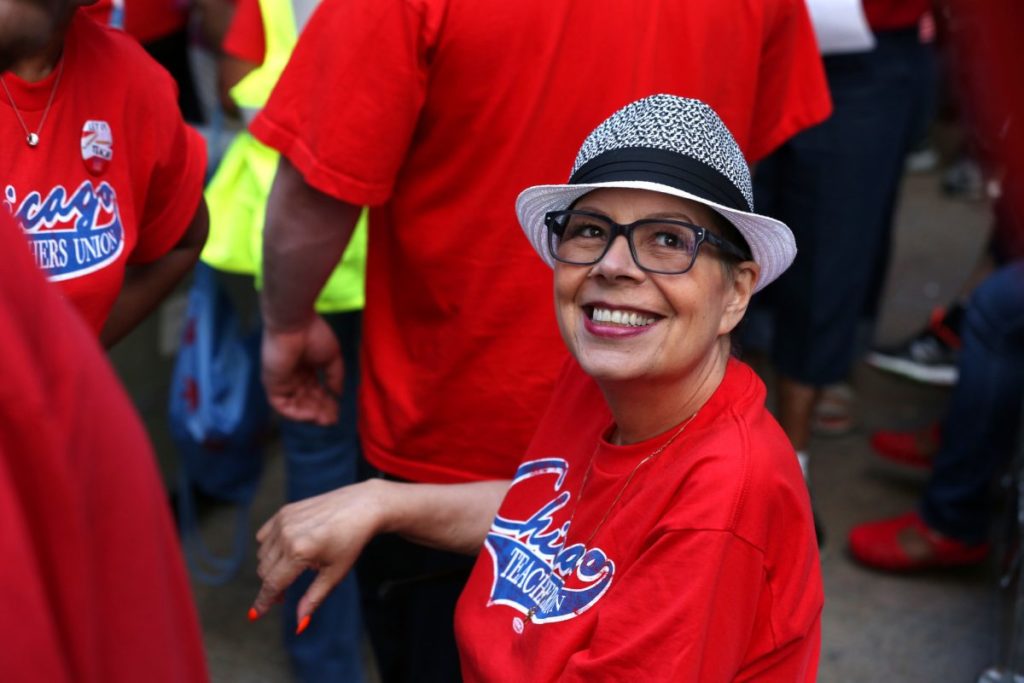When the Caucus of Rank and File Educators (CORE) started out in 2008, we were like an exhibition team entering a league where one powerhouse team had dominated the landscape for over half a century. Needless to say, we were underdogs until the unexpected happened. Jesse Sharkey, our current Chicago Teachers Union (CTU) president and then union delegate from Senn High School, began to strike up conversations with Karen Lewis, a delegate from King High. Jesse played a critical role in recruiting CORE’s top draft pick into the caucus that proceeded to change the course of history for the CTU, the city and the country.
Karen added a veteran’s gravitas to Team CORE. She had graduated from Kenwood High, a famous Chicago public school, and grown up in the Black middle class on the Southside, daughter of two Chicago public school teachers. As a result, she knew the system and the city better than any of us. Additionally, Karen and her husband, John Lewis, met at Lane Tech as Black teachers sent to integrate a school with a predominantly white staff under the district’s desegregation decree. At Lane, she cut her teeth at being a union delegate, breaking ranks with the union’s leadership and joining the Executive Board after Debby Lynch unexpectedly won the presidency in 2001 as the head of a dissident caucus, Proactive Teachers, the first time a caucus other than the United Progressive Caucus had taken office in the union’s 70-year history.
Karen was by all accounts a renaissance woman: a thespian, comedian, scientist, aficionado of the Talmud, former doctor in training, chemistry teacher, pianist, linguist, a lover and a fighter. On more than one occasion she told the story of taking off her earrings and lathering on some Vaseline to brawl with our class enemies. Subtle, no. Inspiring, without a doubt.
She taught us to see our power
Jesse lovingly called Karen “low down” for her blunt and unvarnished truth talk. At the House of Delegates meeting after her death, Jesse noted that she “taught us to see our own power and believed in the purpose of public education and the justice in it.” At the same meeting, Stacy Davis Gates, the CTU Vice President, celebrated Karen for “prioritizing the hearts and humanity of our members.”
Karen had an uncanny ability to fill a room with laughter and radical politics, and a manner that was initially vilified and later celebrated by the news media. Her aphoristic, bombastic and propagandistic way of painting our class enemies as out-of-touch corporate hacks was genius political theatre. Additionally, she possessed a tremendous ability to reverse the onslaught of negative press we faced upon taking union office and use the media as a tool for communicating to the broader public, parents and communities of color in particular. She called out Rahm Emanuel as the “murder Mayor” and Bruce Rauner, former Republican Governor of Illinois, as an adherent of ISIS for his dismantling of social services; she indicted the whole district for reifying “educational apartheid.” Her characterizations always cut deeply without apology while lambasting the racial and economic disparities in our city with laser-like precision.
In some ways, Karen was an unlikely partner in a left-led project for union revival, while in others she was uniquely positioned to unite the disparate forces within our movement. While interested in rooting out the corrupt and political machine tendencies within the union, she was not a self-described leftist. On many occasions, Karen would ask me, “What am I again, Jackson?” while smirking playfully. I would struggle to answer but often said something like “a blend of social democrat with Black nationalist.” My answer would always tickle her because though she never saw herself as a Marxist, she also did not subscribe to any other particular ideology. Either way, she loved it when Rahm called the CTU “a socialist conspiracy.” Her political instincts were mostly populist and rooted in the experience of Black Chicago.
We built union-community ties
As a leader in CORE and our first co-chair (I had the privilege to serve alongside her in that role), Karen was not just our primary spokesperson. She was also instrumental in constructing the democratic norms and structures key to transforming both CORE and the CTU into an organizing force. She got her hands dirty and was not aloof.
Karen wrote the bylaws and constitution for the caucus, led one of our first study groups (on Naomi Klein’s Shock Doctrine) and led our study groups on the CTU Contract and Constitution. Additionally, Karen chaired CORE’s coalition table with community groups and members of Local School Councils that led the resistance to school closings and the school-privatization plan known as Renaissance 2010. Ren2010, as we all called it, was the brainchild of Mayor Richard Daley’s education trust, the movers and shakers from Walgreens, Boeing, Allstate, Aon, et al. who sat on the Civic Committee of the Commercial Club of Chicago. They aimed to create a “portfolio district” and destroy the union through a New Orleans-style takeover. The plan, launched in 2004, sought to close over 80 schools, predominantly in the Black community, and reopen 100 non-union charters and contract schools in their place. In many ways this effort made Chicago ground zero for neoliberal education reform in the country.
In very significant ways, Karen’s leadership method was forged in the baptism by fire of our first administration from 2010 to 2013. District CEO Ron Huberman and Mayor Daley immediately came for us with a budget crisis, demanding that we forfeit scheduled salary increases or suffer 4,000-plus layoffs. We refused concessions and absorbed a much smaller number of layoffs. Karen noted the bluff of threatening massive attacks and acting on something much less draconian for future bargaining strategy and the importance of standing our ground.
We were subsequently hit by a bill known as SB7, enacted by a state legislature fueled by million-dollar political donations and ad buys by astroturf groups like Stand For Children (or, as Karen called them, “Stand On Children”) and Democrats for Education Reform. These groups were funded by the same corporations that led the Civic Committee of the Commercial Club of Chicago, and had been the architects of the majority of neoliberal attacks on public education over the previous 30 years. The bill stripped the union of key bargaining powers and made us the only union in the state that must get 75% of our active membership to vote to approve a strike in order to authorize strike action. After this highly coordinated and vicious attack, Karen picked herself off the mat and proceeded to envision a union that could alter the political sphere in ways that would prevent the future and imminent destruction of our union.
Part of her reimagination of the union involved support for initiating the CTU’s first organizing department, first research department and a reconfiguration of staff that allowed greater resources for member outreach, coalition work and strike preparation. Additionally, it was Karen’s vision, along with the political instincts of Stacy Davis Gates and Brandon Johnson, that became a template for new political formations leading to teachers getting elected at all levels of city, state and county government. Our community coalition, the Grassroots Education Movement (GEM), seeded the wave of socialist and left aldermen storming Chicago’s City Council, including Byron Sigcho Lopez, who worked with GEM while executive director of the Pilsen Alliance, and Jeanette Taylor, a leader in the education justice work of the Kenwood-Oakland Community Organization. According to Jeanette, “Karen, actually brought the families, parents and communities into the union.”
Karen never wanted credit for the gargantuan collective effort by thousands of member leaders, community allies, organizers and rank and file activists that revived the CTU. She always recognized that it takes a village. Nonetheless, it was her life-force that imbued a movement that hasn’t stopped growing since she helped spark it. The 2012 CTU strike set the stage for the 2018-2020 strike wave in Arizona, Chicago, West Virginia, Kentucky, Oklahoma, North Carolina, Oakland, Denver, St. Paul and Los Angeles. It marked the moment when #RedforEd began to supplant austerity and corporate ed reform with educational equity and investments into our school communities. While we are far from matching the school funding received by wealthy, white, suburban districts, these agreements, won by well organized, popular strikes, get us closer all to Karen’s vision for public education.
While we are all deeply saddened that Karen is gone, she will, as Alderman Taylor said, “rest in red.” Karen Lewis will continue to reverberate in our memories and history books for her valiant efforts and sacrifice to win the schools our students deserve.
A version of this article is also being posted on Jacobin, https://jacobinmag.com/

